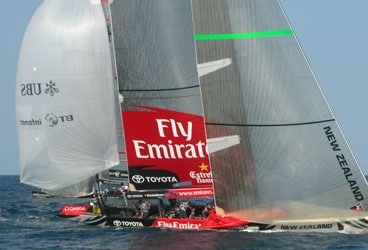
BurnhamValenciaRace3
A more exciting race for the America’s Cup has yet to be sailed. In today’s Race 3, the lead changed hands right after the start, three times on the second upwind leg, and again just before the finish. At one point, after the first leg, Emirates New Zealand led by nearly 400 meters, but that lead disappeared shortly after the leeward gate marks due to a windshift and a troublesome spinnaker takedown aboard the challenger. The defender, Alinghi, took the lead near the end of the third leg, but New Zealand recovered on the run to win by 28 seconds, a margin that in no way reflected the wildly gyrating pulse rate of crews and supporters alike throughout the race.
Not everyone was happy with the race committee’s decision to sail the race in admittedly light and shifty winds. “We could have played tiddly winks and gotten the same results,” said Dean Phipps, Alinghi crewman. “We’re looking for an even boat race, and [today] it obviously wasn’t.”
Predictably, New Zealand strategist Ray Davies felt it was a race worth sailing. “There was some luck involved,” he said, “but certainly there are patterns out there, too.”
The third race of the America’s Cup started in approximately 8 knots of wind, after a couple of postponements. Dean Barker, at the helm of Emirates New Zealand, claimed the right side at the start even though he had to pay for it with a late, slow start on port tack, eight seconds behind an accelerating Alinghi on starboard. However, the wind soon shifted New Zealand’s way and the challengers moved into the lead. Protecting the right side of the course, New Zealand sailed into some extra pressure and more righthand shift. Each time a puff came in they lifted further off Alinghi, stretching to a lead of nearly 400 meters.
Behind by 1:23 at the first mark, Alinghi jibed early and carried a puff down the middle of the course, then found a couple more good shifts to make good gains on New Zealand downwind. Still, the Kiwis were comfortably ahead when trouble struck approaching the leeward mark. According to Davies, the wind shifted 15 degrees just before they got to the mark, which made a good takedown very difficult. Then mid-bowman Richard Meacham slipped and fell overboard seconds before the mark rounding. Whether it was the shift or the distraction as Meacham hauled himself back aboard, the spinnaker ended up getting tangled with the jib sheets, slowing the turn further. To make matters worse, when Alinghi rounded the same mark one minute later, they had a wind shift that lifted them well above New Zealand’s line, and within two minutes of rounding they were closing fast.
New Zealand tacked twice to cover the defender, forcing the Swiss team to the left, where they found a shift that allowed them to pull even. The next time Dean Barker’s crew came across to cover, the Swiss boat gained a windward position and moved slightly ahead. On the leeward side, New Zealand eventually squeezed closer and forced Alinghi to tack away, but the next time the two boats came together, Alinghi had gained. With the right of way, New Zealand made a text-book match-race move forcing Alinghi to tack once more, but on the last cross, Alinghi crossed clear ahead and rounded the final mark 15 seconds ahead.
America’s Cup class boats have difficulty staying between a trailing boat and the finish on a light-air downwind leg because of the disturbed air cast forward by the boat behind. New Zealand split to the left side of the course after a few minutes and made a small gain, then crossed over to the right and gained more.
Alinghi strategist Murray Jones was up the rig looking at the wind. “He thought it looked pretty even,” said Alinghi crewman Rodney Ardern. The two boats split hundreds of meters laterally across the course, and the wind shift Alinghi needed to jibe on never came. Team New Zealand gradually pulled ahead, crossing the line first after one more jibe.
As the winner of the Louis Vuitton challenger series, New Zealand had sailed a number of competitive races in light winds, and their overall speed and crewwork looked stronger than Alinghi’s during the race. Alinghi’s Phipps felt the defender’s two crews had sailed plenty of good in-house races in light winds, but admitted, “We might have pulled the pin earlier some days.”
So against all predictions, the New Zealand challenger holds a 2-1 lead after three races of the 32nd America’s Cup. Alinghi may still have the faster boat in stronger winds, but so far the winds have remained light and New Zealand has seized its opportunities. This reporter has to leave Valencia tomorrow, but I would encourage readers to click over to www.sailingworld.com for top-flight reporting as this extremely competitive series goes forward this week.







